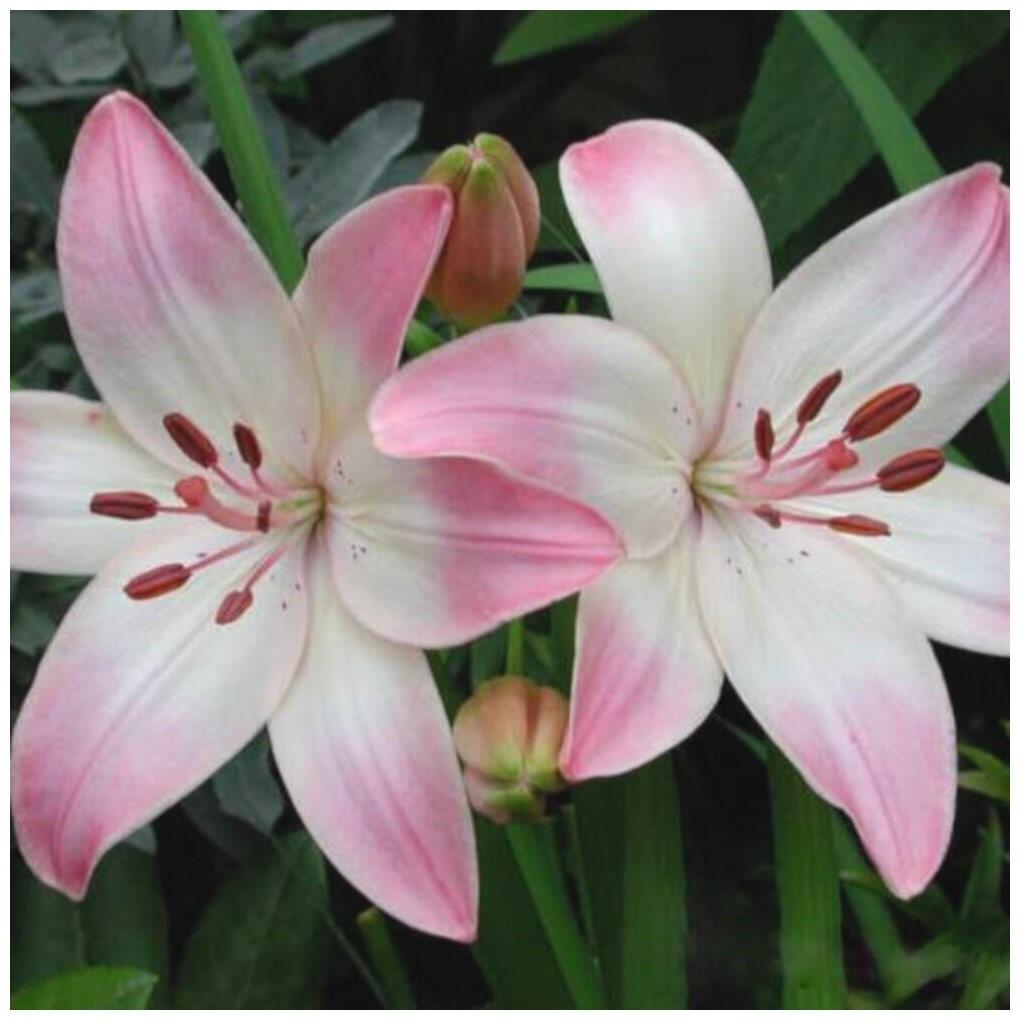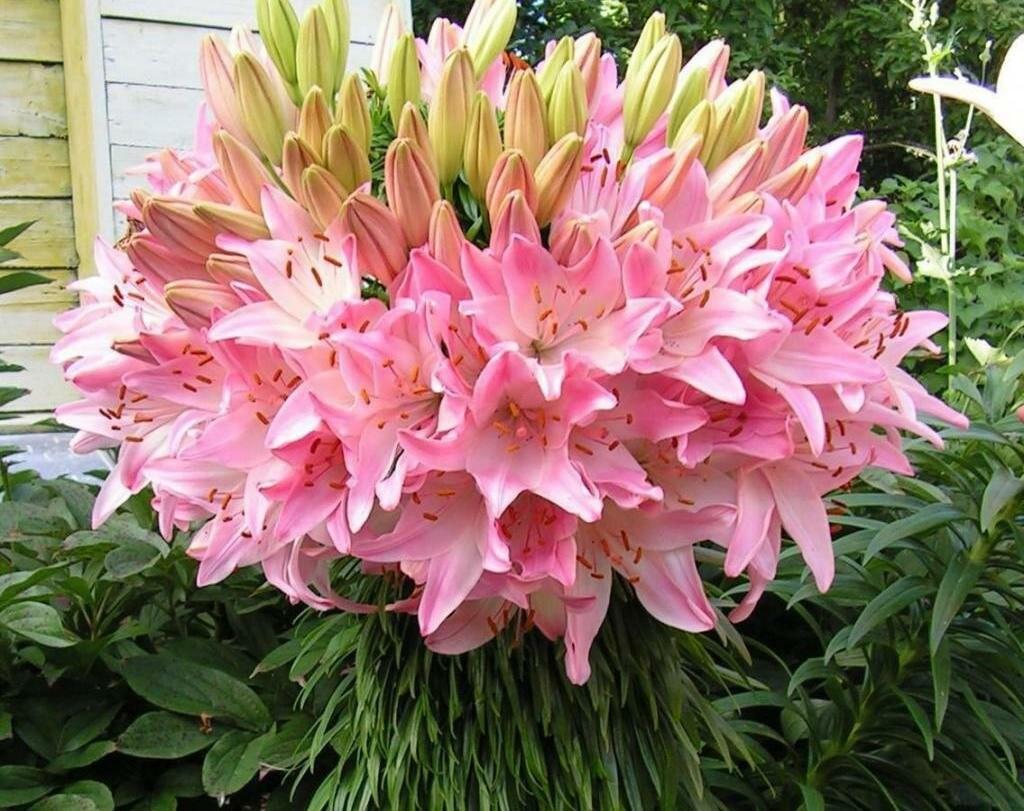Content
Lily Marlene is an unpretentious flower that is grown as an annual under Russian conditions. In mid-spring, bulbs are planted, which already produce large (17-20 cm) flowers at the end of June. For the winter, they are dug up and stored in a cool place.
History of appearance
The Marlene lily is an Asian hybrid that was developed through selection of Asian cultivars with long-flowered varieties. Thanks to this, the plant has absorbed the best qualities of both representatives - it produces large flowers and at the same time is very resistant to adverse weather conditions.
The name of the variety is no coincidence; it is associated with one of the German songs of the World War II era, which was called “Lili Marlene”. Since the plant turned out to be unpretentious and at the same time beautiful, it almost immediately received many positive reviews and spread widely in different countries.
Description of the globular lily Marlene
Lily of the Marlene variety produces a lot of shoots with a height of about 100-110 cm. They grow together due to a mutation at the gene level (the phenomenon of fasciation). Thanks to this feature, the bush produces many flowers, so it looks very beautiful.
All shoots are erect and can withstand the load of inflorescences well. The leaves are elongated, of typical shape, with a pointed tip. The leaf plates are arranged alternately. The surface is glossy and shines beautifully in the sun. The color is rich green, creating a beautiful background against which the flowers themselves look advantageous.

Variety Marlene produces large flowers of soft pink color
Important! There are several lilies that look like Marlene. They are similar in color and flower shape. Among them are Belonica, Pink Perfection, Mantitoba Fox, Arsenal, Muscadet and others.
Features of flowering
Marlene lily flowers reach 17-20 cm in diameter, so they look very impressive. They are used both for decorating the garden and for cutting (making bouquets and floral arrangements). The color is soft pink, attractive. At the same time, the central part is almost snow-white.
The type of flowers is non-double, i.e. their petals are arranged in 1 row. The flowering period falls in June and July. At this time, the Marlene lily bush looks especially beautiful. The very first flowers can be expected 70-80 days after planting, i.e. in a maximum of three months. The shape is classic six-petal, star-shaped. The flowers have no special aroma.
Advantages and disadvantages
The Marlene lily produces beautiful pink flowers in very large quantities. This is a plant with a medium flowering period, so you can wait for the buds to appear in any region. In addition, the culture is a hybrid. It is highly resistant to temperature changes and rainy weather, and grows normally in partial shade.

The plant is attractive not only because of its flowers, but also because of its shoots with leaves.
Pros:
- very large buds;
- appear in large quantities;
- suitable for cutting;
- resistance to drought and other adverse weather conditions;
- immunity to many infections;
- easy to propagate.
Minuses:
- cannot winter in open ground;
- the flowers don't smell like anything.
Planting Marlene lilies
Lily Marlene grows quite normally both in partial shade and in full sun. Therefore, the landing site can be chosen freely. The optimal soil type is loam; sandy loam or sandy soil is also suitable. It should be quite loose and fertile. If the site has heavy clay soil, you should first add sawdust or sand in the amount of 3-5 kg per square meter.
It is advisable to start planting the Marlene lily in mid-spring, i.e. from the end of April until the first ten days of May. Autumn planting is allowed in the southern regions, for example, in the Krasnodar Territory and the North Caucasus. In other areas, Marlene lily bulbs purchased in the fall should be stored in a cool place in the winter, for example, in a pantry or refrigerator (temperature 0-6 degrees Celsius).
The landing process itself looks like this:
- A month before the start of work, the site is dug up and compost and humus are added (a bucket of 1 m2) or complex mineral fertilizer (40-50 g per 1 m2).
- Mark several holes 15 cm deep at a distance of 20-30 cm or more.
- Deepen the bulbs and sprinkle with soil.
- Water with settled water.
- Sprinkle a small amount of sand on top.
Caring for the Marlene lily
To grow a beautiful multi-flowered Marlene lily, just follow a few simple rules. First of all, it is necessary to provide regular watering, since both the general condition and the duration of flowering depend on this. If there is no rain, water twice a week, and in hot weather - every day.It is better to do this late in the evening, and the water should be pre-settled.

For long-term flowering, Marlene lilies are fed three times per season.
After watering, the soil is periodically loosened and weeded as necessary. To ensure that as few weeds grow as possible, plantings can be mulched with peat or sawdust. The protective layer will help the soil stay moist longer, so watering can be reduced slightly.
Another condition for the long flowering of the Marlene lily is the application of fertilizing. You need to do this three times throughout the season:
- When the first shoots appear, water with mullein infusion 1:10 or other organic fertilizers. You can replace ammonium nitrate with 15 g per 10 liters.
- At the stage of the appearance of the first buds, you should use complex fertilizers, for example, “Kemira Lux”.
- After flowering ends, the Marlene lily is fertilized with superphosphate (40 g per 10 l) and potassium sulfate (30 g per 10 l). They can be replaced with wood ash (200-300 g per 10 l).
In late autumn, complete pruning should be done at the root. After a few days, the bulbs are transferred and stored in cool conditions, such as a refrigerator. They must first be disinfected with any fungicide, for example, treated with Fundazol.
Therefore, it is possible to leave it in the soil for the winter only in the southern regions. But then, after pruning, the plantings must be thoroughly mulched, for example, with straw, and covered with agrofibre on top.
Reproduction
The Marlene lily variety can be propagated both by vegetative methods and by seeds. The latter method is more labor-intensive because it requires growing seedlings.In this case, the seeds can be collected independently when the capsule-shaped fruit turns brown (but at the same time remains closed). The germination of seeds is not the same - some may sprout this year, some may sprout next season.
Therefore, in practice, vegetative methods of propagation are more often implemented:
- growing from scales;
- cuttings
In the first case, several scales are separated from the Marlene lily bulbs by simply pressing a finger at their base. Each scale must remain intact, otherwise it will not sprout. They are washed and disinfected in a pink solution of potassium permanganate, then stored in a bag with moss (the place should be dark). After 1.5 months, the scales produce small bulbs, which can be left for storage or planted in open ground.

The scales are separated carefully so that they can rise
Another method of propagating Marlene lilies is to take cuttings from young leaves or stems. Moreover, this should be done at the very beginning of summer, before the flowering period. An oblique cut is made at the end and immediately planted in a pot with fertile soil. Cover with a jar, periodically water and ventilate. After 1-1.5 months you can already transplant it into a flowerbed.
Photos in landscape design
The Marlene lily is beautiful in itself, so it is often used in single plantings, for example, to decorate flower beds near the entrance, bench, or gazebo. It also looks beautiful in combination with other plants of the bulbous group, both perennials and annuals. Combinations with the following colors are especially successful:
- asters;
- carnation;
- garden chamomile;
- marigold.
Compositions with other ornamental plants are also beautiful:
- thuja;
- juniper;
- cypress.
Another interesting option is to plant Marlene lilies in a large pot or container.It is easier to care for such a plant, and if necessary, it can be moved to any place to create a new composition. Another plus is that in case of unfavorable weather, the container can be moved to any place, and for the winter period it can be moved to the basement, where a moderately cool temperature is maintained.
The main ways to use Marlene lilies in garden design are shown in the photo:
- Single landing.
- Composition with dahlias.
- Planting in rows.
Then, along with Marlene, you should choose varieties with different flowering periods, for example, curly (early) and tubular (late).
Conclusion
Lily Marlene will fit well into any garden. It produces very large flowers, so it can be used in single plantings. Bushes look elegant and always lift your spirits. At the same time, they are easy to care for, including in the fall - the dug up bulbs should simply be taken to a cool place and stored there until spring.
Reviews of Lily Marlene











